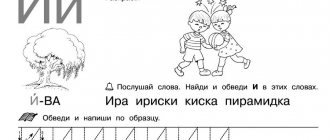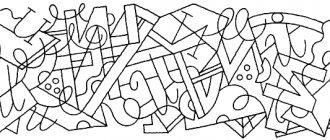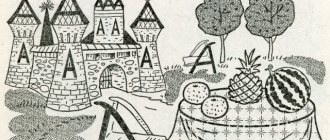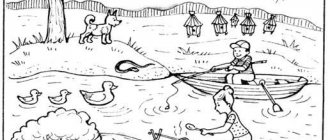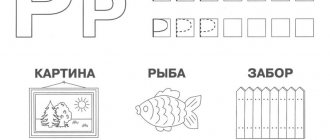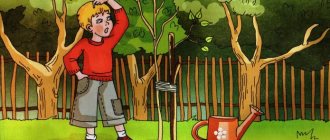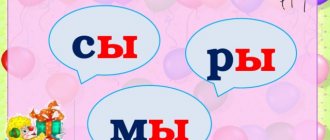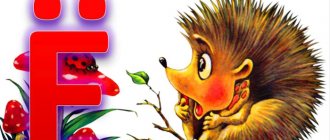Summary of a lesson on teaching literacy to older preschoolers “Sound [a] and letter A”
Lesson notes
“The sound [a] and the letter A”
for older children
Target:
introduce children to the letter A, which denotes the vowel sound [a];
characterize the sound, consolidate the correct pronunciation of the sound a
Tasks:
clarify the pronunciation of the sound [a];
teach children to distinguish the sound [a] from a number of other vowel sounds;
develop phonemic hearing and phonemic perception;
Progress of the lesson
Educator:
Guys, today the doll Anya came to visit us. She has prepared an interesting task for you. Look at the pictures and name them. (Children's answers).
Tell me what is the first sound we hear in all these words.
- That's right, the sound [a] is heard.
Children: They all start with the sound [A]
Educator: Let's all pronounce the sound [A] together (the teacher puts up a picture of the sound being pronounced) with the mouth open wide.
This sound is sung, and when we pronounce it in our mouth, we don’t feel any obstruction, which means it’s a vowel - repeat. We denote vowel sounds in red (red circle). The sound [A] is indicated by the letter A. (The letter A is set).
Development of articulatory motor skills.
- And to make it easier for us to speak, let's stretch our tongue and lips.
- lip exercises: smile – fence – proboscis
- exercises for the tongue: “delicious jam”, “watch”, “swing”.
- Now let's play. Let's pronounce the sound [a] silently, just with our lips - in a whisper - quietly - loudly. For this, the Anya doll prepared magic circles. If it shows a red circle, then you will pronounce the sound [a] loudly, blue - quietly, green - in a whisper, and if white - silently.
And the sound can be pronounced for a long time, aaaaaaaaaaaaaaa (the teacher pronounces the sound and moves the pointer along the path and pronounces the sound for a long time), or it can be pronounced briefly. A. (the teacher pronounces the sound and moves the pointer along the path and pronounces the sound briefly).
Game “Find out by sound”
.
- Now get your palms ready. You need to clap your hands when you hear the sound [A]. Be careful, let's start the game:
- A, U, I, M, O, A, S, E
- SA, KU, PY, SO, DI; AS, OS, UM, US, AP
- garden, tree, crayfish, juice, tap, braid, meat, candy.
Physical education minute
Hands up and into a fist,
Hands down and on your side
We'll sit down and say wow
We'll stand up and say, ah-ah-ah
It's time for us to get down to business. (repeat 2 times).
Educator:
Guys, I already said that the sound [A] is indicated by the letter A. (show the letter A)
Save it!!! We hear and pronounce the sound, and we see and write the letter.
Look how I write it. (The teacher writes a letter on the board) and says: shelf, stick and line - the result is the letter A.
Work in notebooks.
We write the printed letter A, and draw a circle next to it with a red felt-tip pen.
Summary of a literacy lesson in the senior group
Summary of a literacy lesson in the senior group “Introduction to the sound “A” and the letter “A”
(First year of study)
Program content:
1.
Develop the skill of clearly pronouncing the sound “a”.
2.
Learn to isolate sounds from a series of vowels.
3.
Develop auditory attention.
4.
Introduce the letter "A".
5.
Develop fine motor skills.
Materials:
Doll, plot picture “Girl rocking a doll”, symbol (card) of the sound “A”, red circle, card with the letter “A”
(from the alphabet), sticks, workbook, colored pens.
I. Organizational moment
- The one who names the sign of autumn will sit down.
1.
Finger gymnastics “Autumn leaves scattered”:
Autumn scattered leaves, wave-like movements with palms.
I decorated them with a brush . Smooth strokes of the palms up and down.
We will go to the autumn park, “Walking” with the fingers of both hands.
We will collect leaves into bouquets. Cross your palms with your fingers spread out.
A maple leaf, a leaf from an aspen tree, Bend your fingers one by one, starting with
Oak leaf, rowan leaf, large, on both hands at the same time
A red poplar leaf for each leaf.
He jumped down onto the path. They clap their hands loudly.
2.
- Guys, we have a doll visiting us today. Her name is Ann. She has prepared a task for you.
Listen and name the first sound in the words:
arch, antenna, watermelon, acrobat.
- That's right, the sound “A” is heard. This is a vowel sound, it is sung and we don’t feel any obstacle in our mouth when we pronounce it. Look at the picture: a girl rocks a doll and sings “AAAA” to it.
II. Main part.
3.
Articulation of sound.
- Let's make a sound
"A".
Open your mouth wide
We gently rock the doll. (Pronounced individually and in chorus, with different voice strengths - quieter, louder.)
4.
– Look at the pictures carefully and name them.
(Work in Konovalenko’s notebook).
— Circle the pictures whose names begin with the sound “A”.
- Well done, the names of these pictures begin with the sound “A”.
5.
- The task was completed. Now look, I have a red circle in my hands - this is a symbol of the sound “A”. This is how we will designate it.
6. Game “Clap your hands when you hear the sound “A”:
a, y, o, a, s, i, a, e, y, a.
6.
Introducing the letter "A".
— Listen to the poem:
The letter A is tall and slender.
It looks very much like an arch.
- Look at the letter “A”. (A card with the image of the letter “A” is displayed).
- Find the letter “A” in your notebook, in the upper right corner. Run your finger over it (circle) and color it with a red pencil. Why red, who can tell me?
- Because the sound “A” is a vowel and we denote it in red.
7.
“You’ve worked hard and your fingers are tired, let’s stretch them.”
Finger gymnastics “We shared an orange.”
— See how you can form the letter “A” from your fingers:
The index and middle fingers of the right hand are lowered down, the remaining fingers are clenched into a fist, and the index finger of the left hand forms a crossbar.
Let's try to put it together.
8.
Laying out the letter “A” from sticks, drawing in the air.
9.
Print the letter "A" in your notebooks.
Sh.
Summary of the lesson, assessment of children.
- Guys, remember what sound we met in class today?
- With what letter?
- What color do we use?
— What did you like most?
- Well done, they studied well, listened carefully, answered questions.
Summary of the lesson “Sound and letter A”. Lesson on generalization and systematization of knowledge
Topic: sound and letter A.
Lesson type: lesson of generalization and systematization of knowledge.
Goal: to systematize students’ knowledge about the vowel sound and the letter A.
Educational: - Continue to teach how to isolate the vowel sound [A] and designate it with a letter.
Corrective and developmental: - Form finger and articulatory motor skills - Develop phonemic perception and representation. — Form sound-syllable analysis and synthesis. — Continue to work on developing kinesthetic sensations. — Correct thinking based on practicing the operation of analysis and synthesis. — Develop the perception of shape by working with geometric shapes. — Use health-saving actions to maintain performance and expand the functional capabilities of the students’ body (dance of vowels, physical exercises, alternation of various types of activities). — Correct attention based on the formation of the ability to distribute.
Correctional and educational: - To develop the ability to understand and accept an educational task posed in verbal form; — Continue to learn how to answer questions during the course of study with adequate use of the learned terminology. — Develop the ability to actively comprehend the material covered.
Equipment: Demonstration material: PC, PP presentation. Handouts: Mirrors, match sticks, homework cards.
Progress of the lesson:
1. Organizational moment The one who recognizes the geometric shapes will sit down.
2. Articulation gymnastics Let's prepare our tongues for work.
3. Finger gymnastics Work with sticks. Laying out figures according to the pattern. Clarification of the name.
4. Work in a notebook in a square Sketching an oval. Hatching the oval from left to right.
5. Repetition of what has been covered Vowel sounds - they sing, dance, do not meet obstacles. Those who agree stumble upon everything, they stumble over everything. Consonants encounter obstacles in the form of lips, teeth, and tongue.
6. Guessing the topic of the lesson. Pronunciation. Proof. Dance. Sound dance: the child stands, holds his hands in front of him in the shape of a wide oval.
7. Working with the articulatory profile Determining the position of the lips, teeth, tongue, and the functioning of the vocal cords when pronouncing a sound. Conclusion: The sound is a vowel.
8. Work with signal cards and in notebooks. Search for the sound [A] in words. If there is [A] in the word - a card with a + sign, if not - with a sign - Orally: army, cat, fish, shower, mushroom, bull, March. In writing: table, sled, hole, scales, smoke, roof, hand.
9. Listening to an audio recording about the sound and letter A. Recording the topic of the lesson.
10. Aunt Owl’s story about the letter A Finding out which words you remember. Clarification of the lexical meaning of these words.
11. Reading forward and backward syllables (choral, in turn) Writing any two syllables in a notebook. We write down the letters of vowel sounds with a pen with red ink.
12. Phys. pause o/r Hammer-hamster hamster (make movements according to the text) Striped flank. The hamster gets up early, washes his cheeks, rubs his neck. Khomka sweeps the hut and goes out to exercise. One, two, three, four, five, Khomka wants to become strong.
13. Working with pictures from the monitor screen. (At the board and in the notebook). Recognition of objects. Recording the names of objects with pronunciation on the board and in a notebook. The letters of vowel sounds are in red. Division into syllables. Repetition of the rule: the number of vowels in a word, the number of syllables.
14. Lesson summary
Presentation for the lesson notes “Sound and letter A”
| The presentation on slide 20 has a link to the video below. You can download the original presentation file. |
Video for lesson notes “Sound and letter A”
Also on topic:
logoped18.ru
Target.Teach children to isolate the sound [a] in a stressed position at the beginning of a word; start introducing vowel sounds; practice expressive pronunciation of words, the ability to determine the sequence of sounds in onomatopoeic words; focus on the plane of the sheet (direction from top to bottom); draw straight lines from top to bottom; familiarize yourself with the image of the letter Aa.
Equipment.
A set of pictures and toys, panels of letters; individual sheets of white paper with clouds drawn at the top, pencils for each child; sound houses.
Progress of the lesson
I. 1. The teacher tells the story, highlighting (drawing out) the sound [a] in the words with his voice.
- I'll tell you about one dog. She was looking for a friend. The dog wandered down the street and looked into the eyes of passers-by. But no one paid attention to her. A girl ran past with a bouquet of asters. One flower fell. The girl was in a hurry and did not notice the loss. The dog took the flower in its teeth, caught up with the girl and placed the aster in front of her. The girl smiled and said: “Come with me!” The dog was happy and ran after the girl. This is how a homeless dog found a friend.
The girl's name was A-nya. She named the dog A-lyy, because the a-stra that the dog picked up was A-lyy.
All these words, A-nya, A-ly, a-stra, a-laya, begin with the same sound. When I spoke the words, I emphasized this sound.
Name this sound ([a]). Repeat words with the sound [a].
Articulation of sound. When we pronounce the sound [a], the mouth is wide open, the tongue lies behind the lower teeth. The sound is pronounced with the voice. The air stream does not encounter any obstacles on its path.
We will call sounds that are pronounced with the voice and do not encounter obstacles in the mouth as vowels. We will mark the windows in the sound houses where vowel sounds live in red.
Characteristics of sound. The sound [a] is a vowel.
2. - I will name the words. And you repeat them, emphasizing the sound [a] with your voice; the sound is at the beginning of the word: August, address, iceberg, stork, arch. (If necessary, enter an explanation of the meaning of words by the children, and clarification by the teacher)
II. 1. — Our Scarlet barked in a special way. His bark always began with the sound [a]. Guess how he barked: yap, aw, woof? (av).
2. - What is the first sound heard here? ([A]). Sequencing sounds using a sound house. The house has two windows; The first window is red.
3. - Dogs bark in different ways: some loudly, others quietly, some plaintively, others cheerfully. Show how Scarlet barked in the following situations: when he was happy with Anya (loudly), when he was afraid to wake up the owners (quietly), when he was lazy (slowly), when he was chasing the neighbor’s dogs (loudly and often).
III. 1. Getting to know the image of a letter.
- What sound did we meet today? ([A]). I will show you a letter sign that represents the sound [a]. (Show the letter) All letters will live in our group, in their own house. (Showing panels of letters) This house has six floors, each floor has 5-6 apartments. The letter Aa lives at the address: sixth floor (topmost row), apartment No. 1. (Children, with the help of the teacher, find the desired square on the panel and attach the letter to it)
2. Analysis of the letter image.
The teacher examines the letter with the children and asks:
— How many elements are in a letter? (Three) What elements? (Sticks) Are all sticks the same? (No. Two sticks are long, one is short.)
The teacher invites the children to verify the correctness of their observations. Working with scissors. Children cut up the letters given to them. Place the resulting elements in a row. They repeat which elements and in what quantities are needed to obtain the image of the letter A.
3. Letter synthesis.
The teacher offers to form the letter A again from the received elements.
4. The teacher suggests identifying the missing element of the letter. (The letter A has lost one long stick)
"A" ran along the path
And she broke her leg.
IV. Exercise “It’s Raining” to develop orientation on a sheet of paper and reinforce the direction from top to bottom.
“It’s time for us to say goodbye to the girl Anya and her new friend, the dog Scarlet.” They helped us a lot. We introduced them to the sound [a] and the letter A. Anya and Aly are in a hurry to go home, as it is raining outside. (Children take sheets of white paper and pencils)
— Drops from the clouds flew to the ground. Where are the clouds? (Above) How does it rain? (Down) Rain comes from top to bottom Let's draw autumn rain.
Children draw rain (straight vertical lines). The teacher makes sure that their movements are directed from top to bottom. Children can accompany actions by quietly pronouncing words from top to bottom.
